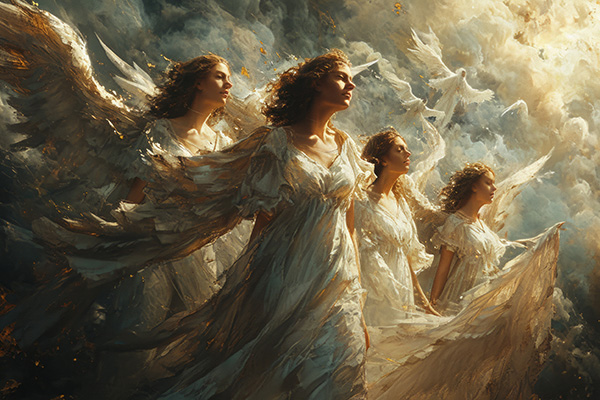The Archangels: Unveiling Their Functions as Celestial Envoys, Representatives, and Restorers
 Historically, across various spiritual practices, archangels have been recognized as celestial messengers and dynamic representatives of the divine. They rank among the most elevated tiers of spiritual entities who support and guide humanity in remarkable ways.
Historically, across various spiritual practices, archangels have been recognized as celestial messengers and dynamic representatives of the divine. They rank among the most elevated tiers of spiritual entities who support and guide humanity in remarkable ways.
An archangel represents a high-ranking entity, frequently characterized as a celestial figure with distinctive authority and an important function in the elevated realms.
The word “archangel” originates from the Greek terms archi (indicating chief or principal) and angelos (translating to messenger). They are seen as leaders of angels, serving as intermediaries between the divine and humankind. They provide protection, direction, and the realization of divine intent.
While multiple religious traditions, such as Christianity, Judaism, and Islam, acknowledge their presence, archangels surpass the boundaries of a single faith.
Numerous philosophical traditions and mythologies have correlations to archangels—celestial or divine entities that serve as messengers, guardians, or mediators between the divine and humanity. Examples include the Amesha Spentas in Zoroastrianism, the Devas in Hinduism, the Bodhisattvas in Buddhist thought, and the Kami in Shintoism.
Even though the number and identities of archangels differ among traditions, some are universally acknowledged and celebrated.
A notable characteristic of archangels is their names, which characteristically conclude with “-el,” signifying “of God” or “in God” in Hebrew. This highlights their profound connection to divine intent and their role as channels between the higher realms and the earthly world.
It is often misunderstood that archangels are entirely spiritual beings, thus are not confined by human traits or characteristics. They rise above these ideas as metaphysical entities. For instance, they possess no specific gender, embodying a genderless or androgynous nature that underscores their universality and availability to all individuals.
The celestial beings akin to stars exhibit empathy towards our human condition, presenting it before God as though it were a book. They assist us. They communicate in a manner that resonates with reason, as inspired by God ~ St. Hildegard of Bingen
Nonetheless, in various religious texts and artistic representations, archangels are traditionally illustrated in accordance with the cultural or societal norms of a specific period or locale. For example, archangels Michael, Gabriel, Raphael, and Uriel are usually portrayed as masculine, particularly within Abrahamic faith traditions.
Conversely, in some beliefs Gabriel, Raphael, and Uriel may instead be depicted as feminine. These portrayals are metaphorical, influenced by human comprehension and narrative rather than literal interpretations.
Below are the most recognized archangels and the aspects of life where they provide assistance:
Archangel Michael
“Who is like God?”
Regarded widely as the chief among archangels, Michael is traditionally illustrated wielding a flaming sword and adorned in armor, symbolizing his function as a formidable protector of humanity. He is recognized as a safeguard against malevolence, shielding individuals from harmful energies, spiritual assaults, and fear. His presence boosts courage, confidence, and inner fortitude, making him the perfect archangel to call upon in times of distress, uncertainty, or danger.
Apart from protection, Michael aids us in overcoming fears, doubts, and anxieties that may obstruct our path to realizing our true potential. He instills resolve and inspiration, assisting individuals in breaking free from addictions, negative patterns, or limiting beliefs.
If you find yourself battling self-doubt or hesitation, calling on Michael’s guidance can empower you to progress with assurance. His energy embodies bravery, ensuring that those who seek his assistance feel safe, supported, and empowered.
Archangel Raphael
“God heals us”
Recognized as the foremost healer among the archangels, Raphael brings solace and rejuvenation to individuals in need of physical, emotional, and spiritual healing. She works to restore equilibrium and tranquility to the body and mind, aiding those recovering from illness, trauma, or heartache. Her energy is soothing and promotes relaxation and serenity, rendering her a wonderful presence for those undergoing stress or anxiety.
Beyond physical healing, Raphael helps cleanse the spirit, releasing trauma from past lives and guiding us through emotional healing journeys. Individuals undergoing significant life changes, healing processes, or personal growth can invoke Raphael for protection, clarity, and strength. Her presence serves as a reminder that healing is a comprehensive process, providing the energy required to rejuvenate both body and spirit.
Archangel Gabriel
“God is my strength”
Gabriel is the archangel of divine communication, wisdom, and insight, often represented with a trumpet, symbolizing the delivery of vital spiritual messages. He is renowned for assisting writers, speakers, and creatives in articulating their thoughts and ideas clearly.
His presence amplifies intuition, guiding individuals in recognizing divine direction and receiving inspiration during uncertain times. Those in search of clarity on their spiritual path can call upon Gabriel to remove barriers and illuminate the right course of action.
Beyond communication, Gabriel serves as a guardian of families, mothers, and children, overseeing pregnancy, childbirth, and domestic harmony. She aids parents in nurturing their children and sustaining a peaceful home environment. As an angel of revelation, she can also impart prophetic dreams and insights that help us comprehend the deeper messages of the Divine. Invoking Gabriel enhances one’s ability to recognize and interpret spiritual signs, making her an invaluable guide for those in search of wisdom and direction.
Archangel Uriel
“God’s Light”
Uriel serves as the archangel of wisdom, intellect, and enlightenment, known for illuminating the mind with divine insight. He assists those seeking deeper understanding, whether through academic pursuits, spiritual exploration, or personal contemplation. When confronted with challenging decisions, Uriel provides guidance and clarity, helping us navigate complex situations with sagacity and discernment. He is frequently sought after by those asking profound questions or grappling with uncertainty in their lives.
In addition to intellectual insight, Uriel offers solace and strength during tumultuous times, especially during natural disasters or unexpected crises. He provides reassurance and support, helping individuals remain grounded and resilient even in difficult situations. For those endeavoring to uncover hidden truths, enhance self-awareness, or expand spiritual understanding, Uriel stands as a potent beacon of light and comprehension.
Archangel Chamuel
“He who seeks God”
Chamuel represents Divine Love. His focus lies in matters of the heart, nurturing love, compassion, and emotional healing. Chamuel can be called upon to mend relationships, whether romantic, familial, or platonic, and to reinstate harmony in strained bonds. For individuals grappling with loneliness or heartbreak, Chamuel offers comfort and solace, reminding us of our intrinsic worth and capacity for love.
As a champion of unconditional love, Chamuel also guides us in pursuing inner tranquility and self-acceptance. His presence encourages a deeper connection to divine love and the ability to recognize it in every facet of life.
Archangel Jophiel
“Beauty of God”
Jophiel is the patron of creativity, art, and aesthetics. She is linked to inspiring beauty in all forms, from artistic expression to appreciating life’s simple pleasures. Jophiel’s energy can ignite the creative spark in those seeking inspiration and can help dissolve mental clutter, encouraging clarity and positive thinking.
In addition to creativity, Jophiel is known for nurturing spiritual growth and awakening divine presence within. By fostering gratitude and mindfulness, she helps us acknowledge the beauty surrounding us and cultivate inner peace.
Archangel Raguel
“Friend of God”
Raguel oversees harmony and fairness among angels and humanity. His role involves promoting justice, resolving disputes, and safeguarding those who are oppressed or unfairly treated. Raguel’s energy embodies divine mediation, providing clarity and balance in conflicts. He is best called upon for guidance when addressing difficult relational issues or seeking peace in challenging situations.
Raguel is also said to uphold order in the angelic realm, ensuring that divine harmony prevails. His presence is comforting and empowering, providing support to those striving for equity and truth in their lives.
Archangel Ariel
“Lion of God”
Ariel is closely associated with nature, the elements, and the safeguarding of the Earth’s environment. She protects animals, plants, and ecosystems, ensuring equilibrium and harmony within nature. Those who feel a strong connection to the natural world or wish to engage in environmental stewardship frequently seek Ariel’s guidance. She aids individuals in developing a deeper appreciation for the natural world, fostering a sense of responsibility for its preservation and welfare.
Beyond her connection to nature, Ariel is aligned with prosperity and manifestation. She assists in transforming dreams into realities, guiding us on our journey to abundance and personal success. Whether you are pursuing financial security, career advancement, or personal development, Ariel provides the encouragement and support needed to progress with confidence. Her presence serves as a reminder that the universe is abundant, and by aligning ourselves with divine energy, we can manifest the resources we require.
Archangel Azrael
“He Whom God Helps”
Azrael is often referred to as the Angel of Death, but his role is one of profound compassion and guidance rather than fear. He assists souls in their transitions from the physical realm to the spiritual one, ensuring a serene and seamless journey. His presence provides comfort to the bereaved, helping them discover solace in sorrowful times. He also supports those engaged in hospice care, counseling, or any field that involves guiding others through challenging transitions.
Azrael’s energy is gentle and calming, offering peace in moments of grief. He helps us process emotions associated with death, loss, and endings, reminding us that life is an eternal journey. For those coping with grief, calling on Azrael can provide emotional healing and a renewed sense of hope, allowing individuals to move forward while honoring their loved ones.
Archangel Camael
“He who sees God”
Camael is linked with strength, courage, and divine justice. Recognized as a commander of war and conflict, Camael is sought after for help in overcoming challenges or resolving disputes. He is also regarded as a protector of those serving in military or law enforcement, providing guidance and strength to them and their families.
Moreover, Camael acts as a mediator between divine forces and human struggles. His energy encourages us to face our fears and stand firm against adversity while promoting fairness and divine order across all life aspects.
Archangel Haniel
“Grace of God”
Haniel embodies harmony, grace, and natural healing. She is often associated with the moon, feminine energy, and matters of intuition. Haniel is invoked for guidance when working with crystals, practicing alchemy, or exploring spiritual rituals. Her energy is known to enhance natural healing processes, bringing balance and renewal to both body and spirit.
Haniel also inspires those keen on enhancing their communication and confidence. She offers support during public speaking or other scenarios necessitating clarity and composure. Her presence is nurturing and empowering, helping individuals align with their inner truth.
Archangel Raziel
“Secrets of God”
Raziel is the Keeper of Divine Mysteries. He is linked with unlocking the universe’s secrets and guiding us to access divine wisdom. Raziel’s energy is believed to enhance spiritual understanding, directing those keen on grasping deeper truths of existence. He is commonly depicted holding a book, symbolizing concealed knowledge and esoteric teachings.
Raziel is also thought to help decode intricate spiritual symbols and concepts, making him a valuable ally for those on a quest for enlightenment. His presence is illuminating and inspiring, offering clarity to individuals seeking to comprehend the divine workings of the cosmos.
Archangel Barachiel
“Blessing of God”
Barachiel is recognized as the archangel of blessings, abundance, and divine grace. She brings God’s generosity to those who seek his guidance, ensuring individuals receive the spiritual and material resources they require. Her presence encourages gratitude, reminding us to acknowledge and appreciate the blessings already present in our lives. By cultivating an abundance mindset, Barachiel helps us attract greater prosperity and joy.
In addition to material blessings, Barachiel offers emotional and spiritual fulfillment. She strengthens faith, deepens personal connections with the Divine, and enhances one’s sense of purpose. Those feeling lost or disconnected can call upon Barachiel for reassurance and guidance, trusting that divine support is always attainable.
Archangel Jeremiel
“Mercy of God”
Jeremiel serves as the Archangel of Life Review, guiding us in evaluating our past experiences and gaining insights into our spiritual journeys. He encourages self-reflection, helping individuals learn from past trials and make constructive changes for the future. His guidance proves especially beneficial during periods of transformation, aligning us with our higher calling.
Beyond life assessments, Jeremiel enhances clairvoyance and prophetic vision, aiding in the development of our spiritual gifts. Those seeking direction in interpreting dreams, signs, and intuitive messages can call upon Jeremiel for clarity and enlightenment. His presence nurtures wisdom, self-awareness, and spiritual growth, empowering us to traverse our paths with confidence and grace.
How To Work With The Archangels
Archangels provide profound guidance, protection, healing, and wisdom. They exist beyond the limitations of any single faith and are accessible to anyone seeking their support. Here are practical ways to deepen your connection with them and invite their presence into your everyday life.
Understand Their Specialties
Each archangel exhibits unique traits and areas of assistance. Being aware of their roles enables you to reach out to the appropriate one for specific situations:
Michael – Spiritual protection, bravery, and overcoming fear.
Raphael – Physical and emotional healing.
Gabriel – Communication, creativity, and divine messages.
Uriel – Wisdom, insight, and problem-solving.
Chamuel – Love, relationships, recovering lost items, inner peace.
Jophiel – Beauty, inspiration, uplifting thoughts, eliminating negativity.
Raguel – Harmony, justice, resolving conflicts, divine order.
Ariel – Nature, animals, environmental healing, abundance.
Azrael – Comfort during grief, soul transitions, emotional healing.
Camael – Strength, divine justice, overcoming challenges.
Haniel – Intuition, lunar energy, grace, feminine power.
Raziel – Mysticism, esoteric wisdom, spiritual knowledge, divine secrets.
Barachiel – Blessings, prosperity, divine abundance, joy.
Jeremiel – Life review, spiritual visions, prophetic dreams, guidance for major life changes.
Clear Intentions
Archangels honor free will and respond to genuine, focused requests. Before reaching out, take a moment to center yourself and articulate a clear intention. Be specific about your needs.
Example: “Archangel Michael, I invite your presence into my life today. Please safeguard my energy and guide me to act with confidence and courage.“
Prayer & Affirmations
Speaking out loud or silently affirming your connection reinforces your request. You can craft your own prayers or utilize established affirmations.
Example: “Archangel Raphael, please envelop me in your healing light. Restore my body, mind, and spirit to a state of balance and well-being.“
Repeating affirmations such as “I am guided and protected by divine light” further solidifies your connection over time.
Meditation & Visualization
Meditation aligns your energy with the archangels. Close your eyes, take deep breaths, and visualize a radiant presence enveloping you. During meditation, you may receive intuitive insights, sensations of warmth, or symbolic imagery as signs of their presence.
Colors & Crystals
Every archangel is linked to a particular color and crystal, which can enhance your connection:
Michael – Blue light (protection, strength) | Lapis Lazuli
Raphael – Green light (healing, renewal) | Emerald, Malachite
Gabriel – White or copper light (clarity, inspiration) | Moonstone
Uriel – Golden light (wisdom, enlightenment) | Citrine
Chamuel – Pink light (love, relationships, inner peace) | Rose Quartz
Jophiel – Yellow light (beauty, joy, uplifting thoughts) | Yellow Jasper
Raguel – Pale blue light (harmony, justice, conflict resolution) | Aquamarine
Ariel – Green or peach light (nature, animals, abundance) | Rose Quartz, Moss Agate
Azrael – Cream or pale yellow light (comfort during grief, soul transitions) | Yellow Calcite
Camael (Cameal) – Red light (strength, divine justice, overcoming challenges) | Red Jasper
Haniel – Silver or turquoise light (intuition, lunar energy, feminine power) | Moonstone, Selenite
Raziel – Rainbow light (mysticism, divine secrets, esoteric wisdom) | Clear Quartz, Labradorite
Barachiel – Soft pink or gold light (blessings, prosperity, divine abundance) | Golden Topaz
Jeremiel – Violet light (life review, spiritual visions, prophetic dreams) | Amethyst
Integrate these elements into your visualizations, carry the crystals with you, or place them on an altar to strengthen your energetic connection.
Signs & Synchronicities
Archangels convey messages through subtle signs, such as repeating number sequences (111, 444), feathers, vivid dreams, or sudden intuitive realizations. Remain receptive to receiving messages through conversations, literature, or moments of inner knowing.
Gratitude
Expressing gratitude for their assistance deepens your relationship with the archangels. After a prayer, meditation, or request, always pause to express appreciation. Gratitude fosters a positive energy exchange and fortifies your spiritual connection.
By incorporating these practices into your daily life, you nurture a significant relationship with the archangels and open yourself to their wisdom and support.
|
Mystic Shelley is a five-star psychic, Reiki healer, clairvoyant, and empathic reader. She provides her clients with honest insights about past, present, and future events with the aid of her trusted guides. Her readings encompass love, relationships, career, finances, and all aspects of life. Mystic Shelley was born with talents that would later distinguish her as a gifted psychic, yet she initially chose not to embrace them. In her 30s, a fortuitous encounter with a renowned psychic redirected her toward embracing her gifts. With the assistance of her psychic mentor, she expanded her natural abilities and gained proficiency over time. Presently, she has cultivated a devoted clientele who speak highly of her abilities. Additionally, she actively supports other psychics in recognizing their own gifts. If you seek direct and honest answers, consider getting a reading with Mystic Shelley at PsychicAccess.com |
The Archangels: Discovering Their Roles as Divine Messengers, Emissaries, and Healers
Throughout history, numerous spiritual traditions and religions have acknowledged celestial entities known as archangels. Believed to function as divine messengers, emissaries, and healers, these influential beings hold important roles in the spiritual sphere. In this article, we will examine the concept of archangels, their functions, and their significance across various cultures.
Archangels are regarded as a higher echelon of angels, frequently portrayed as formidable and majestic beings. The exact count of archangels varies among different belief systems, but several names consistently appear in religious texts and traditions. Some of the most renowned archangels include Michael, Gabriel, Raphael, Uriel, and Metatron.
One key role attributed to archangels is that of divine messengers. They serve as intermediaries between the divine realm and humanity, imparting crucial messages, guidance, and revelations. For example, Archangel Gabriel is commonly linked to communicating messages from God. In Christianity, he is recognized for announcing the birth of Jesus to the Virgin Mary, whereas in Islam, Gabriel is believed to have revealed the Quran to the Prophet Muhammad.
Archangels also act as emissaries, embodying the divine will and undertaking specific tasks on behalf of the divine. Archangel Michael, for instance, is often depicted as a warrior, defending and protecting the righteous against malevolent forces. In numerous religious traditions, Michael is viewed as the commander of the heavenly hosts, combating darkness and evil.
Apart from their roles as messengers and emissaries, archangels are thought to possess formidable healing capabilities. Archangel Raphael, whose name means “God heals,” is frequently associated with healing and divine intervention concerning health and well-being. Many individuals seek Raphael’s assistance for help with physical, emotional, and spiritual healing.
Distinct cultures and spiritual traditions hold unique interpretations and beliefs about archangels. In Christianity, each archangel is often connected with specific virtues and characteristics. Michael embodies courage and protection, Gabriel signifies communication and revelation, Raphael represents healing and compassion, while Uriel is linked with wisdom and enlightenment.
In Judaism, archangels are seen as heavenly entities that play vital roles in the divine hierarchy. Metatron, frequently called the “scribe of God,” is believed to document humanity’s deeds and actions. Uriel, by contrast, is regarded as the angel of repentance and salvation.
New Age and esoteric perspectives also encompass archangels within their spiritual practices. Many individuals call upon archangels for guidance, protection, and healing, believing that by invoking their presence, they can access their divine qualities and receive support in various life aspects.
Regardless of one’s religious or spiritual beliefs, the idea of archangels provides an intriguing glimpse into the mystical and celestial dimensions of human existence. Whether perceived as divine messengers, emissaries, or healers, archangels symbolize a bridge between the earthly and the divine, offering solace, guidance, and inspiration to those who seek their assistance. Continue reading















